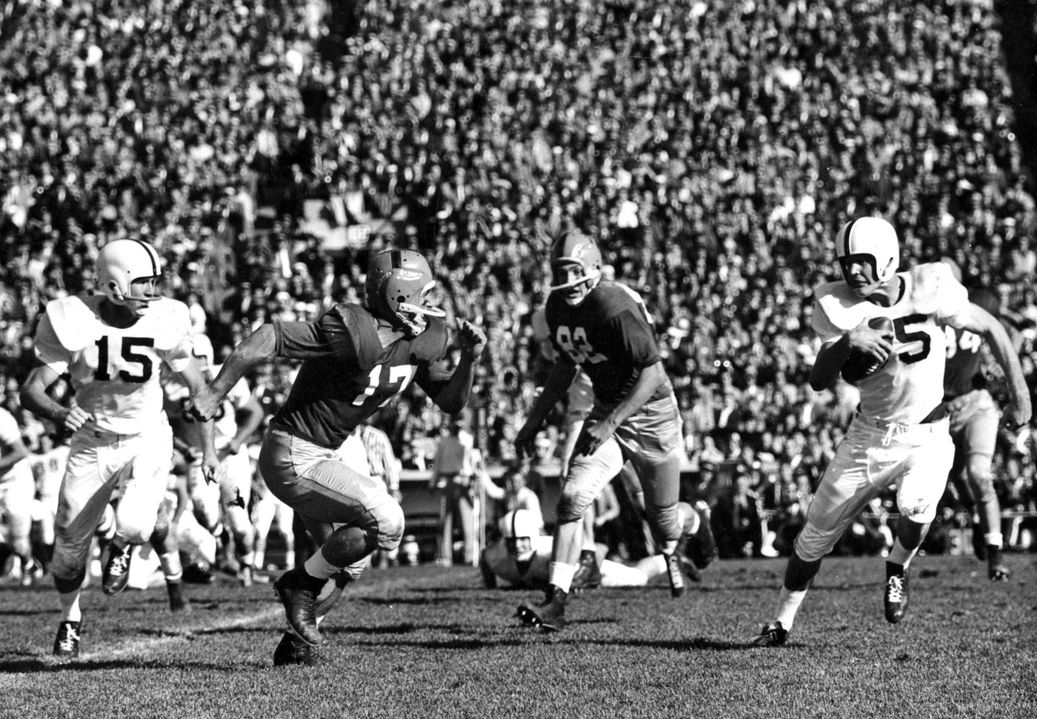Aug. 28, 2014
By Todd Burlage
Jim Morse admits he couldn’t have been prouder a couple of weeks ago when he finally got a chance to enjoy a moment he had been waiting a couple of years to see and savor.
Surrounded by a handful of University of Notre Dame football coaches, much of his family and a few friends, Morse got a sneak peak at the new football field he made happen in Notre Dame Stadium through his selfless donation to the University that means everything to him.
“The field is so beautiful, how could we not like that? It’s perfect,” says Morse, who brought a football with him on his “field trip” so he could test out the new FieldTurf surface with a game of toss and catch. “It is absolutely gorgeous.”
The pride in his voice alone makes it clear that Morse was thrilled after his dress rehearsal at Notre Dame Stadium. But this Irish legend certainly is no stranger to the Notre Dame football field. Not hardly.
A three-year starter for the Irish at right halfback from 1954-56, Morse actually ended up one of the most productive receivers out of the Notre Dame backfield in program history, and one of the most successful businessmen in University history as well.
“Notre Dame is one of the preeminent universities in the country,” Morse says. “And to look back at the success I had while I was there and since I have left there, I would say that Notre Dame has played a great part in that.”
As a football player, Morse shared a locker room with a Who’s Who of Irish greats and all-Americans, including quarterback Ralph Guglielmi, fullback Don Schaefer, offensive guard Al Ecuyer, two-way standout Jim Mense, National Football League veteran Ray Lemek, and of course, 1956 Heisman Trophy winner Paul Hornung — a classmate of Morse’s.
“There were just a whole lot of great football players when I was there,” Morse says. “You kind of take it for granted at the time, especially at a place like Notre Dame. But looking back now, you realize how blessed you were to play with some of these greats.”
And as a successful private investor, Morse has dabbled in everything from mobile home parks and outlet malls to radio stations and aviation. In fact, he’s been in private jet purchasing and leasing since 1978. As an example, Morse recently leased his private plane to professional golfing legend Greg Norman.
“I have always been interested in something new, different challenges. I have a diversified background. I did everything, but none of it very well,” Morse says of his business interests, and apparently his terrific hiring practices. “But I always was smart enough to find somebody good to run my businesses so I didn’t have to run them myself. And that was a good idea because I didn’t know anything about the businesses I was buying.”
In addition to his investment endeavors, Morse has made a few bucks off his gift of gab, spending a few years working as a football play-by-play and color commentator for several national media outlets — most notably as the ABC Radio voice of Notre Dame football from 1964-67.
Morse fondly remembers being a part of the broadcast team that was fortunate enough to cover the arrival of Ara Parseghian as the new Irish head coach in 1964.
“Obviously, you had to perform once you got your foot in the door,” Morse says, “but I think the fact that I was a Notre Damer probably got me in the door to a lot of the jobs I had.”
And that’s why Morse finds it so important to give back to a University that has served him so well.
Morse’s long list of gifts to Notre Dame includes the Morse Family Scholarship Fund, which supports about 12 students annually; funding for football and baseball scholarships; an endowed fellowship for MBA students; and a significant donation to create the Morse Recruiting Lounge in the Guglielmino football complex, a second-floor space that features banners to recognize Notre Dame’s 11 consensus national football titles.
He also helped underwrite the Coleman-Morse Center, home to Notre Dame’s First Year of Studies, the Academic Services for Student-Athletes offices and the Office of Campus Ministry.
“I think it is important to give back,” Morse says. “And I think it is particularly important to give back and help some of these kids that otherwise would not be able to go to Notre Dame because of the cost.”
Morse has also been a generous benefactor to Catholic education in his hometown of Muskegon, Mich. The Notre Dame Monogram Club honored him in 2004 with the prestigious Moose Krause Distinguished Service Award.
“Jim is such a great Notre Dame man and friend of the University,” says Notre Dame athletics director Jack Swarbrick. “This (FieldTurf) project resonated with him because of his football past.”
Memories and Records
Morse never won a Heisman Trophy or became an All-American, but his place in Irish football lore forever will remain strong.
A mainstay at right halfback under head coach Terry Brennan, Morse actually made his mark more as a pass catcher than a pure rusher. During an era when the forward pass was more of an anomaly than a reliability, Morse became just the ninth Irish player to lead Notre Dame in receiving in multiple seasons — 17 catches for 424 yards in 1955 and 20 catches for 442 yards in 1956 — setting a couple national and program standards along the way.
Morse’s 442 yards in 1956 set a single-season record at Notre Dame. But perhaps more impressively, his five catches for 208 yards in 1955 against USC set a single-game NCAA record for average yards per catch (41.6), a mark that still stands at Notre Dame almost 60 years later for Irish receivers with at least five receptions in a game.
Morse remains one of only two Irish running backs to catch passes for more than 1,000 yards in a career, an incredible accomplishment with just 52 career receptions. Interestingly, Morse’s predecessor at tailback, Joe Heap, is the only other Notre Dame running back to reach the 1,000-yard receiving mark.
“Those are things you just don’t forget,” says Morse, who may be best remembered by the older Irish guard for his 179 rushing yards and decisive 72-yard touchdown run to cap a 23-14 comeback win against USC in 1954. “Those memories always will remain very special to me.”
With almost all of his business interests sold, Morse has slowed down some these days. He still attends about four or five Irish games each season, but spending time with his wife, Leah Rae, his six surviving children and his 24 grandchildren is top priority now.
A proud father of seven, Morse tragically lost a son, Jim Morse Jr., to a brain tumor when Jim Jr. was just 42. The loss of his namesake son, a defensive back at Notre Dame in the mid 1970s, is part of his drive to keep giving back.
“I went to Notre Dame on a football scholarship and my son went to Notre Dame on a football scholarship,” Morse says. “So to me, it just seems so fitting that we help some of the kids today as we were helped years ago here at Notre Dame.”
And while Morse’s allegiances obviously belong to his alma mater, a proud father took what he calls a “great hiatus” from his Irish football following when he attended 47 consecutive Michigan State games to watch his son, Bobby, play running back for the Spartans from 1983-86.
“He started his first game as a freshman,” Morse says of his son, “and ended up playing 47 games in row from there.”
Bobby was selected by the Philadelphia Eagles in the 12th round of the 1987 NFL Draft and played four seasons with the Eagles and New Orleans Saints, slightly one-upping his father on draft day. Jim was selected by the Green Bay Packers in the 13th round of the 1957 NFL Draft.
Dad’s NFL career never blossomed but he did play two seasons with the Calgary Stampeders of the Canadian Football League before becoming a media personality, businessman, trucking executive, investor and even a sports agent for a bit.
“It’s clear the kids I represented (as an agent) were bigger, stronger and faster than when I played,” Morse says with a laugh. “But to bring them back to earth, I liked to tell the kids they were bigger, stronger, faster and dumber!”
And that’s Jim Morse — funny, smart, interesting, successful, caring and sharing.
It forever shows in his passion for family, and in his generosity to a University he came to love as a child watching Irish football legends such as Johnny Lujack and Leon Hart.
It shows with a beautiful new football field that would have never been possible without his generosity.








